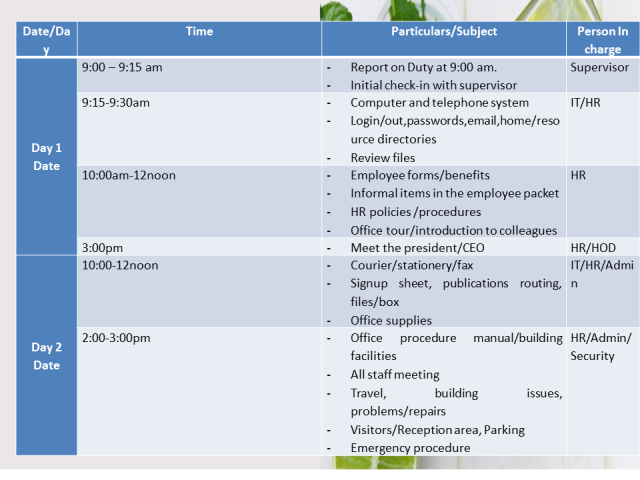Orientation and Onboarding | The Onboarding process for new employees
Orientation, also called Onboarding,
is designed to provide new hires with the information they need to function
comfortably and efficiently in the organization.
Typically, Induction
is a planned introduction of fresher’s to their jobs, their peers and the
company which conveys three types of information:
1.
General
information about the daily work routine
2. A review of
the firm’s history, founders, objectives, vision, mission, operations, products/services
details. Also, how the new employee’s job contributes to the organization’s
needs.
3. A detailed
presentation in a brochure or classroom session. The focus of such Job
orientation sessions will be more into the organization’s policies,
work rules and employees benefits.
Typically, topics covered in new hire orientation are specified in the diagram1.1
 |
| Diagram1.1 |
Purpose of new employee orientation| the first Impression
The first
step in facilitating a smooth transition to an employee’s workplace is an effective employee onboarding process.
It also sets the stage for his/her long-term impression of the
organization. The first impression creates a lasting impression.
“Research
suggests that new employees decide within the first 30 days whether or not they
feel welcome in the workplace.”
The whole
idea behind this exercise is to make the new employee feel ‘at home’ in the new
environment. If expectations are realistic, adjustments will be relatively
simple.
Finally, a
good orientation
programme can be instrumental in setting realistic employee
expectations, creating a favourable first impression, and a lasting effect on
curbing absenteeism and turnover.
Typical new employee Orientation Schedule (sample diagram1.2 below)
While
designing an effective company employee
program, there are four strategic choices:
1.
Formal or
informal
2.
Individual
or Collective
3.
Serial or
Disjunctive
4.
Investiture
or Divestiture
Among all
these four variants, most common is Formal orientation,
This
consists of three stages:
1.
A general
Introduction to the company, mostly taken care of by HR or L&D.
2.
Department
Specific orientation, mostly by the supervisor or immediate boss.
3.
Orientation
follow-up meeting, basically a Q&A session for clarifying doubts of either side.
 |
| Diagram 1.2 |
Respective orientation schedule should contain few
requisites to be effective e.g,
1.
Determine
information which new employees want to know
2.
Determine
how to present information, and
3.
Completion
of paperwork.
Evaluation: An effective employee onboarding process should avoid following errors
- Supervisor
who is entrusted with the job is not trained or is too busy
- Employee is
overwhelmed with too much information in a short span of time
- Employee is
overloaded with forms to complete
- Employee is
given an only menial task that discourages job interest and company loyalty
- Employee is
asked to perform a task where there are high chances of failure that could needlessly
discourage the employee
- Employee is
pushed into the job with a sketchy orientation under the mistake believe that ‘trial
by fire’ is the best orientation Employee is forced to feel in the gaps between
a board orientation by the HR department and a narrow orientation at the
departmental level
-
Employee is thrown
into action too soon
- Employee’s
mistakes can damage the company image
- Employee may
develop wrong perceptions because of short periods spent on each job.
Orientation
checklist to be followed – HR Department
& Supervisors
HR department Orientation Checklist
-
Name of
employee
-
Starting
date
-
Department
Prior to orientation
-
Complete
form A and give or mail to new employee
-
Complete
form B
-
Attached
Form B to orientation
-
Checklist-
supervisor and give to the supervisor
Employee’s first day: Organization and personnel
policies and procedures
-
History of the
Company
-
Organization
chart
-
Service to
community-purpose of the company
-
Employee
classification
Insurance benefits
-
Group health
-
Disability
-
Life
-
Workmen’s
compensation
Other benefits
-
Holidays
-
Vacation
-
Death in the
family
-
Health
services
-
Professional
discounts
-
Appointments.
End of orientation – Day one
-
Make appointments
for orientation day - two
-
Introduce
employee to supervisor
Other items
-
Job posting
-
Bulletin
board - location and use
-
Safety
-
No drinking
-
Where to get
supplies
-
Employee’s
records- updating.
-
HRIS/HRMS –
employee portal training
-
Name of
employee
-
Starting
date
-
Department
Employees first day
-
Introduction
to co-workers
-
Tour off
department
-
Tour of
company
Location of
-
coat closet
-
Restroom
-
Telephone
for personal use and rules concerning it
Working hours
-
Starting and
leaving
-
Lunch breaks
-
Overtime
-
Early
departures
-
Time clock
Pay policy
-
Pay period
-
Deposit
system
Other items
-
Parking
-
Dress
During Employees first two weeks
emergencies
-
Medical
-
Power
failure
-
Fire
Employee’s second day
-
Pension
Retirement Plan
-
Sick leave
-
Personal
leave
-
Confidentiality
-
Complaints
and concerns
-
Termination
-
Equal
Employment opportunity.
Conclusion
message |Company orientation - onboarding new employees
Whatever is the
approach, the feedback from the employees enables a firm to adopt its orientation
program to the specific suggestions of the new employees.
Developing a strategic, formal approach to onboarding will lead to Greater employee
retention and engagement. if an organization suffers from a one- size- fits-
all orientation
approach, and if you believe that talent is walking out your door, it
makes business sense to review and strengthen your new hire processes.
Building onboarding
procedures that span the employees’ career are adaptable and flexible
to meet changing needs, and include company-wide leadership will keep your word
for strong.
The main
message for managers is it needs to involve the entire staff an improved
specific measure to determine its effectiveness. It is important to acclimate
new employees to the organization and operational culture. Make sure it is more
than a rundown of Administrative details.
Related HR Blog Post
Comments
Post a Comment
Please do not add any spam link in the comment box